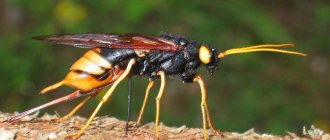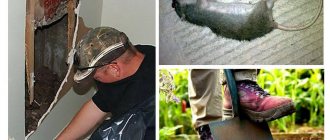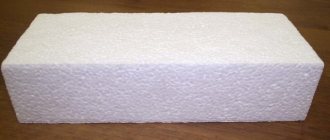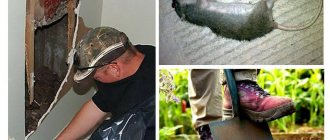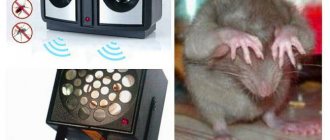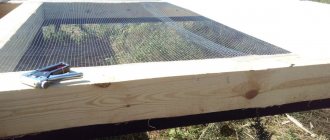The domestic white and clean rat is a tame animal that is distinguished by its sharp mind and quick wit. The pet lives warm and in complete contentment, but if you leave the rat unattended, it will immediately play a cute prank, running away to a place inaccessible to people. Now imagine the same intelligence, ingenuity, survival in any conditions and constant hunger - this will be the “portrait” of a wild rodent.
Rats in the house are a disaster of enormous proportions. Prevention of the appearance of pests is carried out constantly, and if signs of an “enemy” are detected, war is declared on him. And you shouldn’t think that one-time measures will save you from invasion. If rats smell easy prey, they won't leave so easily. Prey is considered to be everything that can be eaten and chewed - from food to cables and insulating material.
Don't underestimate the intelligence of rats. They are social animals with incredible fertility. The rodent will bypass cunningly placed traps, and if an individual is caught, the second one will immediately understand the threat and transmit a danger signal to other animals. Let us remember that rats are pack animals, so when one individual appears, others will not keep you waiting. A smart enemy requires special protective measures, so we will consider all the ways to get rid of rats indoors.
What is the danger of rats in the house?
The first is an unpleasant appearance. In nature, some individuals reach a length of up to 40 cm, but this is with a tail. Seeing this in an apartment or house is an unpleasant sight. But this is not the worst thing:
- Rats carry diseases that are extremely dangerous to humans. These are tuberculosis, rabies, cholera, jaundice, etc.
- Rodents, without a twinge of conscience, will eat all the supplies in the closet; they will not disdain pet food, wiring, insulation, decoration and furniture.
- Rats in the house leave feces, urine, where there are a lot of worm eggs, parasites. Pests carry fleas and ticks on wool.
Cases of rodent attacks on humans have long been known. When squeezed into a corner, the rat will defend itself. She can jump, scratch, bite. An infection from the mouth or claws will get into the wound and the matter can end very sadly. It's even worse when rats appear in a house with small children. The smell of babies is incredibly attractive to rodents, so it is worth keeping in mind and applying methods on how to get rid of rats in the house.
Unpleasant neighborhood: types of rats living next to humans
Several species of rats can live in close proximity to humans, namely:
- Gray or Pasyuki. The largest representatives of the family, which are characterized by increased aggressiveness. The Indian species of rodents lives on the territory of our country. These animals can grow up to 25 cm in length, excluding the tail, and weigh up to 390 grams. The overwhelming majority of individuals have a gray coat color, which can acquire a reddish tint as the mammal grows older.
- Black. They are also called ship rats, since this species is most often found on water transport. In addition, it was the ships that helped these pests spread throughout the planet. A characteristic feature of black rats is the fact that they do not dig holes, preferring to live in nests made on tree branches or in abandoned hollows.
- Earthen ones. Although the animal is very similar in appearance to a rat, it is actually a large species of vole. Representatives of the hamster family nest in the ground, breaking through an extensive system of tunnels with a hole and a storage room.
All species of rodents are highly fertile and can produce up to 2-5 litters per year, which can contain from 5 to 11 cubs. Animals have a high level of adaptation to living conditions and food, which allows them to successfully live and reproduce near humans.
How do rats get into a house and apartment?
As for a private building, everything is clear here - rats in the house appear from the street, from the underground, settle in the attic and in boiler rooms. But city residents are not spared from visits from unpleasant guests. Rodents enter the apartment from various places:
- along air duct shafts;
- from the garbage chute;
- from the basement;
- through sewer mines.
There have been cases when pests entered an apartment through a 2 cm gap, climbed the walls up to the 3rd floor and even settled in elevator shafts. If there are neighbors' garbage bags on the site, this is the best “yummy” for rodents. In a couple of days, a “family” of pests will settle in the entrance, and it will be extremely difficult to get rid of them.
Signs of large rodents
Signs of the presence of a rat How to understand that there are rats in an apartment - you need to pay attention to the evidence. Rodents are extremely careful and try not to show themselves to humans. They are nocturnal. The evidence remains in the morning.
- There is a specific unpleasant odor characteristic of the mouse family.
- Eating food supplies. Rats eat everything a person eats. They can steal meat, lard, cookies, sausage, salad, bread. Any product not hidden in the refrigerator or bread bin.
- Presence of excrement in the form of small black peas.
- Damage to property. Rats' incisors grow daily. To prevent their excessive increase in size, animals are forced to constantly grind their teeth on hard objects. Wooden products, plastic, leather, rubber can be damaged.
- The presence of rustling sounds at night. Rats settle in an apartment under the floor, in the walls, on the ceiling, if there is a layer of insulation there. You can hear the animals gnawing on hard objects, running, and squeaking.
Signs of rats in the house
Spotting smart animals is difficult, but not impossible. If rats appear in the house, they will:
- feces;
- ammonia smell;
- corpses of rats and mice;
- chewed food bags.
One female can reproduce up to 12 times a year. Each litter consists of 8 to 12 individuals. In a year, only one individual will bring more than fifty new “fighters”, and given that there are about 20 animals in the flock, the size of the “army” becomes threatening.
If you see any traces of a rat in the house, be sure to take action. Trace the path to the nest to clearly understand the location of the enemy. If you catch an animal by surprise, you should not rush at it with your bare hands, as this risks bites, bites and serious scratches.
We turn to professionals
Our company professionally deals with the deratization and extermination of rats in Moscow and the Moscow region and the prevention of their occurrence. Before starting work, we carefully inspect basements, ground floors, adjacent areas, and, if necessary, roofs and attics of apartment buildings.
In our work we use special preparations that we spray using hot and cold fog, as well as using smoke bombs. When using them in the basement, we must notify all residents of the house. All necessary licenses and sanitary documents are available. Contact us to get rid of an unpleasant neighborhood.
Rodents such as rats get into the house in different ways. It is known that rats thrive in ventilation and sewer systems. In this regard, many people have a completely reasonable question: can rats get into a house or apartment through the toilet? Are rats in the sewer a myth or reality? Now let's figure it out...
Is it possible for rats to appear from the sewer in the house through the toilet?
The worst thing is that the appearance of rodents from the toilet is not a myth, but a terrible reality. Typically, this unpleasant problem is faced by residents of the lower floors, although there are cases where rats appeared from toilets on the fifth floor and above.
This is due to the fact that rats (both gray and black) are quite smart creatures. They understand that pipes are a fairly convenient way to a person’s home. And in this dwelling, warmth and food await them, so it is vital to strive there.
Rats can move through sewers because they have the ability to swim and hold their breath for a long time (these rodents can swim a distance of ten meters underwater), in addition, rats have a special structure of their paws. They move perfectly along vertical surfaces, clinging to small potholes and cracks.
Preventing the appearance of rats in the house
It will not be possible to completely protect yourself from the penetration of pests from the outside, but a number of measures will help avoid the threat:
- The cracks are sealed with putty. Ventilation outlets are covered with fine mesh. The cell size should be no more than 15 mm; after 20 mm, the offspring will already pass through, which will quickly grow and breed.
- Window openings are covered with mosquito nets. It will become a warning barrier. And if the mesh is torn, they look for rodents and take measures to get rid of rats in the house.
- The gaps between the doors are closed with seals, and the holes for cables are closed with plugs. Hatches are equipped with latches, and drainage channels outside the house are covered with nets.
As preventative measures, timely emptying of the trash can and thorough cleaning of surfaces from food debris helps. It is better to double-check the bags of cereals and seal them tightly. And, of course, you shouldn’t flush leftover food down the toilet; this smell will literally “lure” rodents into your house and apartment.
Essential measures
Rodent control in an apartment should be carried out at the level of the entire house. It is necessary to collect signatures from residents and write a complaint to the appropriate authorities. Specialists must respond to requests for rodent extermination and carry out deratization in basements and entrances.
The next step should be to prevent home invasion. In new buildings, where the floors and walls are concrete, the only entry option is sewerage. All that remains is to put a lid on the toilet with significant weight, and not a light plastic one. Then the rat will not be able to lift it and get further into the room.
In an old house, it is necessary, if possible, to strengthen the space from the floor at a distance of 20 cm. Rats gnaw everything except those materials that are much harder than teeth. Concrete, iron structures, and metal mesh are not susceptible.
Ways to eliminate rats in the house
Let’s say right away that the options of catching and releasing pests do not have any effect. When choosing ways to get rid of rats in the house, owners use the most effective means. Let's look at some of them.
Traps
The effectiveness of traps is no more than 30%. Regardless of the type or type of device, smart animals will soon learn to recognize danger and will not go where they will die. The only exceptions are “outsiders”; the traps can handle them quite well.
Ready-made devices of mechanical and electronic types are offered for sale. Before getting rid of rats using a homemade device, they calculate the size of the structure - the rat trap should be much stronger and larger than the mousetrap. The animal can easily gnaw through steel wire and deal with plastic and wood.
Traps are inspected and emptied once a day. Handling pests with bare hands is strictly prohibited. Carcasses are disposed of by fire or thrown into a trash bin.
Poisoned baits
Manufacturers offer a wide range of baits with toxic substances. The effects vary, some cause paralysis, others cause internal bleeding. Home craftsmen themselves prepare mixtures from grain, broken glass, lime and alabaster. After such a “treat” the rat will want to drink, the alabaster will harden, and the pest will die.
Baits are placed in the same way as traps - on the paths to the nest or where the pests have left traces of their vital activity.
It is strictly forbidden to use rat poisons in the house. The poison is dangerous for people and pets. Treatment with chemicals is carried out only by pest control specialists. They will set traps with poison, so it’s easier to shift the problem of how to get rid of rats to them.
A poisoned individual can crawl quite far, so the method is effective, but with some disadvantages. It’s difficult to find a carcass, but you have to look for it, otherwise it will start to emit a terrible smell.
Glue traps
This method of how to get rid of rats in the house is suitable as a preventative measure or for small concentrations of rats. Special glue is applied to a durable base and placed in path areas or near rodent nests. Once the pest steps on the glue, it will no longer be able to leave the trap. Disposing of the individual and laying out new traps is the responsibility of the owner.
Traditional methods
Many people prefer to fight rats in their apartments using traditional methods, as they combine effectiveness and safety for people and pets. To drive away rodents, agents are used whose smell they cannot tolerate:
- plants (ledum, elderberry, wormwood, mint);
- essential oils (tea tree, eucalyptus);
- household chemicals (containing bleach);
- vinegar;
- spices (chili pepper, cloves, coriander).
There are more radical folk recipes with which you can destroy emerging rats:
- a mixture of flour and plaster (alabaster) is scattered along the walls, saucers with water are placed nearby, the mixture eaten and washed down with water hardens in the stomach and leads to the death of the rodent;
- a mass of crushed wine cork, bread and vegetable oil (it swells in the rodent’s stomach);
- a mixture of soda, flour and sugar (once it enters the stomach, it reacts with gastric juice, resulting in the release of gas, which causes the rat to die).
Attitudes towards folk remedies vary; some consider them useless, while others really help. It’s worth trying and drawing conclusions based on your own experience.
Repellers
An ultrasonic repeller is a universal device that will help as a preventative measure even when there are rats in the house. The principle of operation is simple - the device generates a stream of signals that cause discomfort in all rodents. Ultrasound is inaudible to humans and large pets, but domestic mice and rats may feel unwell.
Before exterminating rodents using poisons, traps, or using the services of pest control agents, call our company. The repeller does not kill animals, it drives them away forever. No complicated steps are required to operate - install it in the right place, plug it in or install batteries. At this point, the question of how to get rid of rats in the house will no longer worry you.
Damage from rodents
All members of the family pose a danger to human health and property. Animals are carriers of infectious diseases that can cause death. At the same time, not only rodent bites are dangerous, but also their very presence in the premises or on the territory of a household, since infection can occur in several ways:
- Airborne, by inhaling dust that contains rodent feces;
- Together with water or food with which the pests have been in contact;
- When infection occurs through cuts and abrasions.
If traces of rodent activity appear in the storage areas, then it is too late to think about where the rats came from; it is necessary to immediately take measures to destroy them and sanitize all premises. The most dangerous diseases carried by pests are:
- Leptospirosis;
- Tetanus;
- Hemorrhagic fever;
- Typhus;
- Pseudotuberculosis.
Animal fur may contain dangerous types of ticks and fleas, contact with which can lead to the development of encephalitis or other diseases. Contact with rodents may cause infection with helminths. Representatives of the family can destroy crops in gardens and fields, render individual water supplies unusable, exterminate poultry chicks and steal their eggs. If rats are infested in a car, where they climb in to bask in the warm engine, then the pests can chew through important pipes and all electrical wiring.
Common disposal methods
Different methods affect their conditions, which include the number of pests, the area of treatment, as well as the personal preferences of the owner of the site. Some people do not accept violence, while others are terribly afraid of living rodents.
But most people begin their campaign against parasites with the most accessible, primitive and convenient actions:
- They scare rats with plants that have a very strong and, as is rightly believed, unpleasant aroma for rodents. Place milkweed, elderberry, or blackroot along rat trails, near burrows, and in frequently visited places.
- According to the peculiarity of rats, which have long been noted among the people, they do not settle on ashes, odorous plants are replaced with ash. This is also justified from a scientific point of view, since the alkali it contains has an unpleasant effect on the stomachs of rodents, where it gets from the animals’ paws.
- Singed fur is also, according to popular observations, very frightening to tailed animals. It's rare that anyone roasts the corpse of a real rat in their home, but using a piece of rabbit or any other fur is a good substitute.
- Not all, but many cats are excellent rat catchers, but due to their size they are ineffective in a war against large numbers. Dachshunds or some breeds of terriers are more effective in this field, as practice has shown.
- Gypsum, lime or alabaster diluted with flour are often used to kill rodents. Such baits, when combined with water, harden in the stomachs of animals, blocking the entire digestive system. This is a kind of folk poison.
Since we are talking about poisons, they take first place in terms of applicability and, perhaps, in efficiency, after professional deratization.
First aid for a bite
A rat bite is dangerous due to the possibility of infection with serious diseases. That’s why it’s so important to properly treat the wound. Bites on the neck and face are dangerous due to their proximity to the main blood vessels. This way the infection enters the bloodstream faster. First aid after a bite should be provided within 2–3 hours.
A rodent bites if it is in danger, is afraid or seeks to escape from the trap. Rats infected with rabies do this for no reason. They become more aggressive when they see a person waving a stick or arms.
Wash the wound site with a 20% solution of laundry soap (1/3 piece per 2 cups of water). It is valued for its ability to destroy the rabies virus. It can be replaced with a toilet one, but the effectiveness of the treatment will be lower. A superficial bite is washed for 5 minutes, and a deep wound for at least 10. It is better to do this with an enema (syringe).
A rat bite can lead to a variety of infections, even fatal ones.
If the bite bleeds, do not stop the bleeding immediately. This will wash away germs and bacteria that have entered the wound. After treating it with soap, rinse additionally with an antiseptic - chlorhexidine, 3% hydrogen peroxide, furatsilin. After this, apply a sterile cotton-gauze bandage with antibiotic ointment. Then contact your doctor to find out what additional steps you can take.
What attracts rats and why they are dangerous
For Pasyuks, the search for food and procreation come first. They have long realized that these instincts are best satisfied near a person’s home, so they try to settle where they can feast on food waste, slop and other things. They are attracted to indoor odors, so they are rarely found in places that are clean and tidy.
Tailed rodents are omnivores and use every possible means to get to leftover food.
Rats really like shops, warehouses and pantries where grains, flour, all kinds of cereals and similar food supplies are stored. Food industry enterprises, including cafes and restaurants, are their favorite habitats.
The fact that rats destroy food and damage property is not the most important reason why you should get rid of them. It is also necessary to protect yourself from toothy pests because they are carriers of dangerous diseases, such as tuberculosis, scabies, plague, typhoid and other rapidly spreading infections.
Rats chew on everything, including cables, and this often causes serious damage and fires.
Traps and traps
Both homemade and industrially produced devices for the physical method of breeding rats are inferior to poisons in terms of mass influence. They are divided into those that kill the individual caught in them and the so-called “live traps”. The disadvantage of this method is the inevitability of coming into contact with a living or dead rat, and the need to get rid of it.
Household versions of electric traps are gaining popularity. They are reusable, i.e. there is no need to “recharge” after each operation. Some are designed for 10 rodent carcasses, which are automatically moved to a special compartment after hitting the next victim with an electric discharge.
